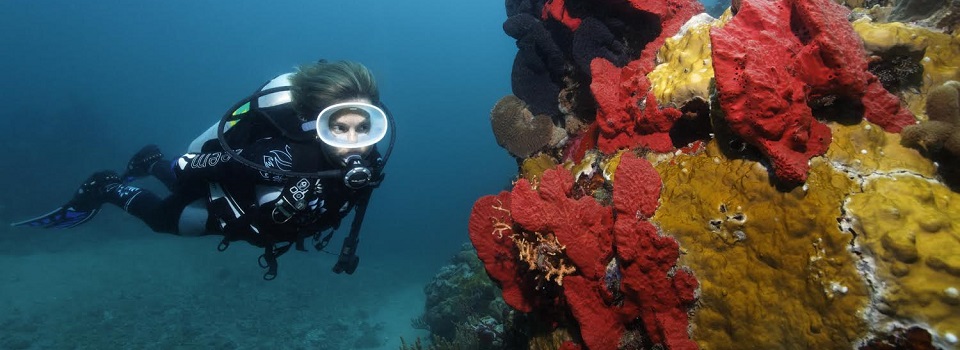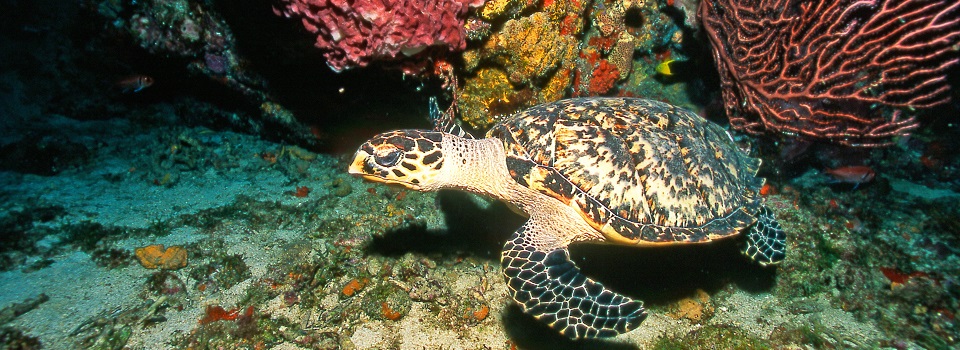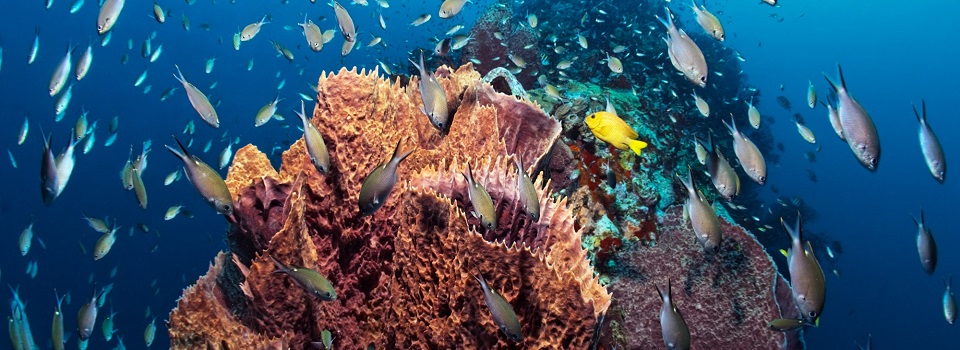Dive Sites
The following is a description of
TURTLE REEF:
 This crescent-shaped reef to the north of Anse Chastanet bay is a secret tip not just for macro photographers. It drops quickly from a plateau area at around 40 feet to well over 150 feet. From the spectacular pillar coral and barrel sponges in the shallows to the deeper soft corals and ledges, this reef offers a wide range of exciting marine life.
This crescent-shaped reef to the north of Anse Chastanet bay is a secret tip not just for macro photographers. It drops quickly from a plateau area at around 40 feet to well over 150 feet. From the spectacular pillar coral and barrel sponges in the shallows to the deeper soft corals and ledges, this reef offers a wide range of exciting marine life.
The occasional turtle has been known to visit, but even if not in evidence, there are plenty of other creatures, like garden eel, gold spotted snake eel, flying gunard, peacock flounder, scorpion-fish, queen angel fish, seahorses and the remains of an old Porsche, which make this dive exceptional. Since the inception of the SMMA, the schools of mahogany snapper and schoolmaster have also returned.
ANSE CHASTANET REEF:
 Take a few short steps across the warm volcanic sand of the Anse Chastanet beach and one will find themselves at this spectacular reef. This very popular reef has three distinct areas:
Take a few short steps across the warm volcanic sand of the Anse Chastanet beach and one will find themselves at this spectacular reef. This very popular reef has three distinct areas:
- SHALLOW:
There is a plateau area with depths of 5-25 feet with many brightly colored sponges and soft corals, as well as large brain corals and boulder corals. Goatfish, parrotfish, chromis and wrasse are found all over the shallow reef, and barracudas are also often observed cruising through the water column. At the base of the cliff there is a large cavern with resident frogfish. - MEDIUM:
The reef drops off steeply from 20 to over 140 feet in depth. It forms a solid wall of mixed corals and other marine species. Most of the dives offered by various dive operators are at mid-range depth (between 50-60 feet), allowing divers to see the full range of the reef from the sparkling water surface to the deep reef. This portion of the reef is often visited by many schooling fish, and has a wide diversity of marine life, including various corals, sponges, crabs, lobsters, moray eels, and much more. Deep-water lace coral is also found in this ara. - DEEP:
In the deeper part of the reef, at about 100 feet, other corals give way to plate coral, with layer upon layer of delicate porcelain-like growths stacked one on top of the other. This area is well worth the visit.
FAIRYLAND:
 Adjacent to the Anse Chastanet reef, starting at the West Point, is the beautiful location of Fairyland. This area, located on a major headland, is subject to very strong currents; this has the benefit of giving the site excellent visibility and keeping the corals very clean so that the vibrant colors sparkle, painting the many varieties of coral and sponges. The plateau area slopes gently from 40 to 60 feet; the dives are usually about 50 feet and shallower at this site. Large boulders create numerous nooks and crannies for fish to shelter in, while the water column teams with large numbers of schooling fish, particularly horse-eye-jacks, Bermuda-chubs, chromes and Creole-wrasse. Turtles, southern-stingrays and nurse-sharks are occasionally seen on this splendid reef called Fairyland.
Adjacent to the Anse Chastanet reef, starting at the West Point, is the beautiful location of Fairyland. This area, located on a major headland, is subject to very strong currents; this has the benefit of giving the site excellent visibility and keeping the corals very clean so that the vibrant colors sparkle, painting the many varieties of coral and sponges. The plateau area slopes gently from 40 to 60 feet; the dives are usually about 50 feet and shallower at this site. Large boulders create numerous nooks and crannies for fish to shelter in, while the water column teams with large numbers of schooling fish, particularly horse-eye-jacks, Bermuda-chubs, chromes and Creole-wrasse. Turtles, southern-stingrays and nurse-sharks are occasionally seen on this splendid reef called Fairyland.
Grand Caille
 Patois or Creole translation for “Great House”, Grand Caille has long been known as the home for big fish. Unfortunately, few of these remain due to fishing activities, but this is still a very dramatic dive site, with massive boulders in the shallows, which blend into large reef patches in the deeper part. This dive site also boasts a wall comprising many deep-water gorgonia and sea whips. Occasionally a large barracuda will curiously observe the divers.
Patois or Creole translation for “Great House”, Grand Caille has long been known as the home for big fish. Unfortunately, few of these remain due to fishing activities, but this is still a very dramatic dive site, with massive boulders in the shallows, which blend into large reef patches in the deeper part. This dive site also boasts a wall comprising many deep-water gorgonia and sea whips. Occasionally a large barracuda will curiously observe the divers.
Trou Diable
The “DevilÂ’s Hole” is a fascinating location. At 40 to 60 feet, there is a steep slope with large barrel sponges and well-developed coral heads, with schools of chromis and grunts in abundance. The shallower section at 20 to 30 feet offers an intricate maze of channels around large boulders covered in a profusion of coral and sponges. This is a great spot to find gold spotted eels and spotted drums. If one’s lucky, one might be able to spot the rare sunfish or a hawksbill turtle.
Keyhole Pinnacles
 Many divers have declared that this is one of the most visually stunning dive sites that they have ever visited. Four spectacular volcanic peaks rise dramatically from the depths to within a few feet of the surface. These are encrusted with a profusion of black and orange gorgonia, and this lacy network provides shelter for trumpetfish, filefish, and sometimes seahorses. Larger fishes such as grouper, jack and snapper can also be spotted around the Pinnacles.
Many divers have declared that this is one of the most visually stunning dive sites that they have ever visited. Four spectacular volcanic peaks rise dramatically from the depths to within a few feet of the surface. These are encrusted with a profusion of black and orange gorgonia, and this lacy network provides shelter for trumpetfish, filefish, and sometimes seahorses. Larger fishes such as grouper, jack and snapper can also be spotted around the Pinnacles.
Malgretoute
Under the Petit Piton mountain, Malgretoute, which means “Despite Everything!” is a steep slope with large rocky outcrops, encrusted in colorful sponges and a variety of corals. Among these are the large barrel sponges and bright yellow tube sponges – peek inside these for crabs and basket stars. Because of the healthy reef and good water quality, many flamingo-tongues can be found on the sea fans in shallow water.
Supermans Flight
Located right at the base of the spectacular Petit Piton mountain, whale shark and humpback whales have been observed passing by. The cliff face here was used as a setting for the film Superman 2, where Superman was filmed flying down the cliff face to just above the water. Divers can take this opportunity to continue this flight well below the surface of the water. There are often strong currents on this site, which promotes good visibility. The steep slope presents a number of beautiful soft corals, and a great profusion of fish life.
Piton Piton Wall
Also located at the base of the Petit Piton, this dramatic wall falls from the surface to hundreds of feet below. Sea whips, delicate soft corals, lots of large featherduster-worms and schools of rainbow runners, make this a very colorful and picturesque location. Look out for seahorses hiding in the gorgonian forests along the wall.
Jalousie
 Jalousie is at the base of the Gros Piton mountain, just south of Jalousie Bay. The mountain slope continues to vast depth below the surface of the water. Divers can view lots of schooling fish, particularly creole-wrasse, bar jack and occasionally southern-sennet. There is a great range of coral species and sponges, and plenty of hiding place for moray eels, reef crabs, lobsters and other critters. Explore the crevices for these elusive creatures.
Jalousie is at the base of the Gros Piton mountain, just south of Jalousie Bay. The mountain slope continues to vast depth below the surface of the water. Divers can view lots of schooling fish, particularly creole-wrasse, bar jack and occasionally southern-sennet. There is a great range of coral species and sponges, and plenty of hiding place for moray eels, reef crabs, lobsters and other critters. Explore the crevices for these elusive creatures.
Coral Gardens
This dive starts right at the impressive cliff of Gros Piton. It comprises a steep slope with a variety of corals species and large barrel sponges. The unusual sargassum-trigger-fish can be spotted in the deeper area here, and occasionally a large school of barracuda will take up residence. As with many of the dive sites, divers must be careful to frequently monitor their depth gauge as the slope continues for hundreds of feet. It is easy to get caught up in the beauty on display and descend to greater depths.
NIGHT DIVES:
Heard about “The Thing”? It’s real! This rare, very shy and extremely fast, purple colored, segmented worm is not from a fairy-tale. While moving, its colors glitter in the moonlight, adding to its myth. Animals of up to 15 feet in length have reportedly been seen in the SMMA. Since it can only be observed at night, clear photos of it are scarce and precise identification has proven to be difficult. The creature is harmless to divers and by no means a “beast”. Ever seen bioluminescence, a parrotfish in its cocoon or even coral sex? Predictions of coral spawning at the end of August have become very precise and the event is certainly the night dive highlight of the season. Night dives in the SMMA are a definite must for the serious diver. Octopus, squid, spiny-, slipper-, and peppermint lobster, huge channel clinging crabs, conger eel, banded-, spotted- and goldentail moray eel, electric ray and basket star are just a few examples of nocturnal creatures frequently encountered during night dives.
Wreck of the lesleen M
Also located in the Anse la Raye area, the 165-foot freighter was sunk in October 1986 by the Department of Fisheries as part of a project to provide artificial reefs. It is covered with hard and soft corals, sponges and hydroids, and provides an ideal habitat for many juvenile fishes such as Queen- and French angel fishes. The wreck sits on an even keel on the sand. It is 30 feet to the sand deck, and 65 feet at the deepest point. It is possible to explore the hold and the engine room.
| What am I going to see on the dive? | CAMMA Dive Sites |




